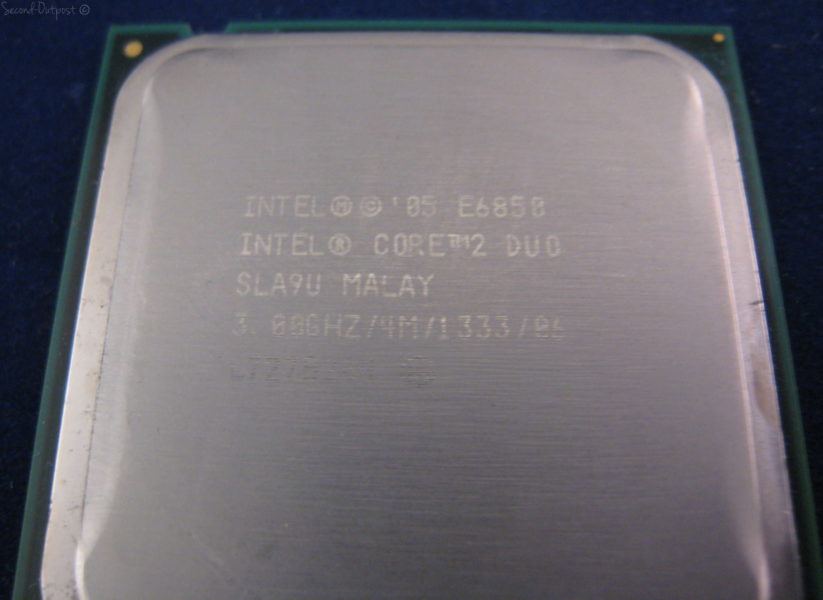

Newer versions of VM software do not support processors older than Nehalem (Core 2 and older) because they lack support for Intel VT-x with Extended Page Tables (EPT), also called Second Level Address Translation (SLAT).įor a detailed discussion of CPU cores, see Intel Core (microarchitecture) § Processor cores. Virtual machine or virtualization abilities Ĭore 2 and other LGA 775 processors can support virtualization if the virtual machine (VM) software supports those processors, e.g. From December 2006, all Core 2 Duo processors were manufactured from 300 millimeter plates at Fab 12 factory in Arizona and at Fab 24-2 in County Kildare, Ireland. Īlthough Woodcrest processors are also based on the Core architecture, they are available under the Xeon brand. Intel Core 2 processors with vPro technology (designed for businesses) include the dual-core and quad-core branches. The Core 2 processor line was introduced on July 27, 2006, comprising the Duo ( dual-core) and Extreme (dual- or quad-core CPUs for enthusiasts), and in 2007, the Quad ( quad-core) and Solo ( single-core) sub-brands. The introduction of Core 2 relegated the Pentium brand to the mid-range market, and reunified laptop and desktop CPU lines for marketing purposes under the same product name, which were formerly divided into the Pentium 4, Pentium D, and Pentium M brands. The Core 2 range was the last flagship range of Intel desktop processors to use a front-side bus. The single- and dual-core models are single- die, whereas the quad-core models comprise two dies, each containing two cores, packaged in a multi-chip module. Intel Core 2 is the processor family encompassing a range of Intel's consumer 64-bit x86-64 single-, dual-, and quad-core microprocessors based on the Core microarchitecture. Pentium 4 (single-core, desktop,core 2's microarchitecture was based on P6, not netburst) Allendale, Conroe, Conroe-L, Merom-2M, Merom, Merom-L, Kentsfield, Wolfdale, Yorkfield, Penryn.Actual TDP may be lower if not all I/Os for chipsets are used. System and Maximum TDP is based on worst case scenarios. Processors that support 64-bit computing on Intel® architecture require an Intel 64 architecture-enabled BIOS. See for more information and applicability of this technology. Max Turbo Frequency refers to the maximum single-core processor frequency that can be achieved with Intel® Turbo Boost Technology. See for more information including details on which processors support Intel® HT Technology. Processor numbers differentiate features within each processor family, not across different processor families.

Intel processor numbers are not a measure of performance.

Please refer to the Launch Date for market availability. Please contact OEM for the BIOS that includes the latest Processor configuration update. Functionality, performance, and other benefits of this feature may vary depending on system configuration. Please check with the system vendor to determine if your system delivers this feature, or reference the system specifications (motherboard, processor, chipset, power supply, HDD, graphics controller, memory, BIOS, drivers, virtual machine monitor-VMM, platform software, and/or operating system) for feature compatibility. ‡ This feature may not be available on all computing systems. Refer to Datasheet for formal definitions of product properties and features. Your company as an importer and/or exporter is responsible for determining the correct classification of your transaction. Any use made of Intel classifications are without recourse to Intel and shall not be construed as a representation or warranty regarding the proper ECCN or HTS. Intel classifications are for general, educational and planning purposes only and consist of Export Control Classification Numbers (ECCN) and Harmonized Tariff Schedule (HTS) numbers.

Please contact system vendor for more information on specific products or systems. The information herein is provided "as-is" and Intel does not make any representations or warranties whatsoever regarding accuracy of the information, nor on the product features, availability, functionality, or compatibility of the products listed. Intel may make changes to manufacturing life cycle, specifications, and product descriptions at any time, without notice. All information provided is subject to change at any time, without notice.


 0 kommentar(er)
0 kommentar(er)
